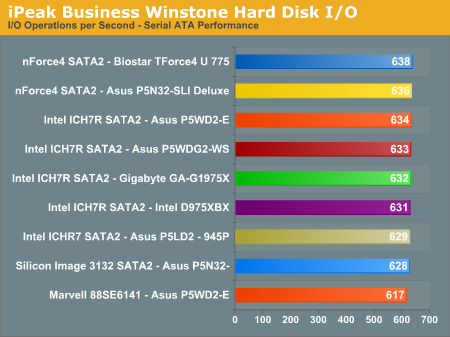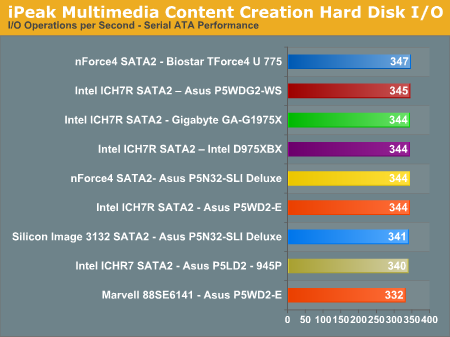NVIDIA nForce4 Ultra: Biostar's Performance Surprise
by Gary Key on February 16, 2006 12:05 AM EST- Posted in
- Motherboards
Disk Controller Performance
With the variety of disk drive benchmarks available, we needed a means of comparing the true performance of the wide selection of controllers. The logical choice was Anand's storage benchmark first described in Q2 2004 Desktop Hard Drive Comparison: WD Raptor vs. the World. The iPeak test was designed to measure "pure" hard disk performance, and in this case, we kept the hard drive as consistent as possible while varying the hard drive controller. The idea is to measure the performance of a hard drive controller with a consistent hard drive.
We played back Anand's raw files that recorded I/O operations when running a real world benchmark - the entire Winstone 2004 suite. Intel's iPEAK utility was then used to play back the trace file of all IO operations that took place during a single run of Business Winstone 2004 and MCC Winstone 2004. To try to isolate performance differences to the controllers that we were testing, we used the Maxtor MaXLine III 7L300S0 300GB 7200 RPM SATA drive in all tests . The drive was formatted before each test run and a composite average of 5 tests on each controller interface was tabulated in order to ensure consistency in the benchmark.
iPeak gives a mean service time in milliseconds; in other words, the average time that each drive took to fulfill each IO operation. In order to make the data more understandable, we report the scores as an average number of IO operations per second so that higher scores translate into better performance. This number is meaningless as far as hard disk performance is concerned, as it is just the number of IO operations completed in a second. However, the scores are useful for comparing "pure" performance of the storage controllers in this case.
With the variety of disk drive benchmarks available, we needed a means of comparing the true performance of the wide selection of controllers. The logical choice was Anand's storage benchmark first described in Q2 2004 Desktop Hard Drive Comparison: WD Raptor vs. the World. The iPeak test was designed to measure "pure" hard disk performance, and in this case, we kept the hard drive as consistent as possible while varying the hard drive controller. The idea is to measure the performance of a hard drive controller with a consistent hard drive.
We played back Anand's raw files that recorded I/O operations when running a real world benchmark - the entire Winstone 2004 suite. Intel's iPEAK utility was then used to play back the trace file of all IO operations that took place during a single run of Business Winstone 2004 and MCC Winstone 2004. To try to isolate performance differences to the controllers that we were testing, we used the Maxtor MaXLine III 7L300S0 300GB 7200 RPM SATA drive in all tests . The drive was formatted before each test run and a composite average of 5 tests on each controller interface was tabulated in order to ensure consistency in the benchmark.
iPeak gives a mean service time in milliseconds; in other words, the average time that each drive took to fulfill each IO operation. In order to make the data more understandable, we report the scores as an average number of IO operations per second so that higher scores translate into better performance. This number is meaningless as far as hard disk performance is concerned, as it is just the number of IO operations completed in a second. However, the scores are useful for comparing "pure" performance of the storage controllers in this case.












31 Comments
View All Comments
Calin - Friday, February 17, 2006 - link
What about sorting the graphs based on the min frame rate?:) I guess some people are never happy ;)
Great job, and a nice article!
yacoub - Thursday, February 16, 2006 - link
Once you've owned a passively-cooled motherboard like any of the recent Asus ones, it's hard to even look at one with a fan on it. It also makes shopping for a motherboard a LOT easier because you just cross off all the fan ones right away (unless you're a mod fiend who will actually go through the trouble of buying a chipset cooler or two and rip the fan assembly off the brand new expensive motherboard and hope that cools it well enough).I hope more manufacturers take up the passively-cooled trend.
Gary Key - Sunday, February 19, 2006 - link
I disabled the fan and only witnessed a 2c increase on the MCP. Biostar could have saved a few cents and put towards a Gigabit Lan solution. ;-)Marlin1975 - Thursday, February 16, 2006 - link
Sound and ethernet. Why do companies keep using the realtek junk. bad quality (part and drivers) and juts shows a motherboard company does not care when they use realtek.Any time I see realtek on a board I think the sound and even ethernet were a after thought like "Oh we forgot sound. Lets just put the cheapest POS on there. OK"
COME ON. Good chipset but you come so close then put junk on for sound and so forth.
Myrandex - Thursday, February 16, 2006 - link
For me that issue doesn't matter at all. My Sound Blaster Audigy 2 is still doing its job nicely, and getting a nice onboard sound solution still gets disabled all the same. Now for integrated SB Giga-bite ethernet is something that comes into play with my decisions, and I have been real happy with Giga-byte putting ieee1394b controllers on their boards (and am hoping that external HDD 1394B cases fall in price sooner or later). Integrated wireless is a neat feature some boards have as well.Wesley Fink - Thursday, February 16, 2006 - link
Realtek does have some really cheap audio and LAN chips, but they also have some pretty decent products. In the High Definition area the ALC882 is a really good audio codec with an excellent feature set that produces decent sound and very low noise. If you go through some recent reviews you will see both Gary and I have praised the Realtek ALC882, which is NOT included on this Biostar board :-)Marlin1975 - Thursday, February 16, 2006 - link
yea but you also go on about bad drivers that are STILL in need fo a update and other issues. So sorry but realtek is still junk in my book. That and with so many other options from VIA's envy, c-media, etc... why use something that has problems and are STILL being addressed today?DigitalFreak - Thursday, February 16, 2006 - link
I agree. Using Realtek for LAN is bad enough, but using a PCI solution? That's unacceptible. Even if you don't care about GbE, the CPU utilization is rediculous!Peter - Tuesday, February 21, 2006 - link
The RTL8201 is not a PCI ethernet chip, it's just a PHY companion to the chipset's own engine. This is a research error in the article.http://www.realtek.com.tw/products/products1-2.asp...">http://www.realtek.com.tw/products/products1-2.asp...
The abysmal performance rather more likely stems from transmission errors or poor signal quality - which would point to a damaged or poorly laid out board, or bad cabling.
PHYsical interface chips have zero influence on throughput, as long as signal integrity is being maintained - and as far as that is concerned, Realtek's solution is definitely up to the job. Question is, is the mainboard's layout?
Peter - Tuesday, February 21, 2006 - link
... and of course, we need to keep in mind it's a 10/100 PHY, not a gigabit PHY.